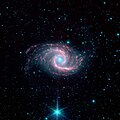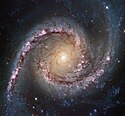NGC 1566
| Galaxie NGC 1566 | |
|---|---|
 | |
| Aufnahme mithilfe des Victor M. Blanco Telescope | |
| AladinLite | |
| Sternbild | Schwertfisch |
| Position Äquinoktium: J2000.0, Epoche: J2000.0 | |
| Rektaszension | 04h 20m 00,4s[1] |
| Deklination | −54° 56′ 16″[1] |
| Erscheinungsbild | |
| Morphologischer Typ | (R'_1)SAB(rs)bcSy1[1] |
| Helligkeit (visuell) | 9,4 mag[2] |
| Helligkeit (B-Band) | 10,2 mag[2] |
| Winkelausdehnung | 8,3′ × 6,6′[1] |
| Positionswinkel | 60°[2] |
| Flächenhelligkeit | 13,6 mag/arcmin²[2] |
| Physikalische Daten | |
| Zugehörigkeit | Dorado-Gruppe • LGG 114[1][3] |
| Rotverschiebung | 0,005017 ± 0,000007[1] |
| Radialgeschwindigkeit | (1504 ± 2) km/s[1] |
| Hubbledistanz H0 = 73 km/(s • Mpc) | (59 ± 4) · 106 Lj (18,2 ± 1,3) Mpc [1] |
| Durchmesser | 140.000 Lj[4] |
| Geschichte | |
| Entdeckung | James Dunlop |
| Entdeckungsdatum | 28. Mai 1826 |
| Katalogbezeichnungen | |
| NGC 1566 • PGC 14897 • ESO 157-20 • IRAS 04189-5503 • GC 844 • h 2635 • Dun 338, LDCE 0328 NED011 | |
NGC 1566 ist eine Balken-Spiralgalaxie vom Hubble-Typ SBbc im Sternbild Schwertfisch am Südsternhimmel. Die Galaxie ist etwa 59 Millionen Lichtjahre von der Milchstraße entfernt und hat einen Durchmesser von etwa 170.000 Lichtjahren.
Mehrere Messungen, die nicht auf der Rotverschiebung basieren, ergeben einen Abstand von 9,5 ± 4,6 Mpc (etwa 31 Millionen Lichtjahre), der außerhalb der mit dem Wert der Verschiebung berechneten Abstände liegt.[5]
Sie als Seyfert-Galaxie Typ 1,5 klassifiziert, deren zentrales Schwarzes Loch riesige Mengen an Materie akkretiert und dadurch intensive Strahlung aussendet, da sich diese auf extrem hohe Temperaturen aufheizt. NGC 1566 ist nach Messier 77 die zweithellste uns bekannte Seyfert-Galaxie. Sie ist außerdem das hellste Objekt der Dorado-Gruppe.[6]
Die Galaxie wurde am 28. Mai 1826 von dem schottischen Astronomen James Dunlop entdeckt.[7]
- Ultraviolettaufnahme mittels GALEX
- Hochaufgelöste Aufnahme des Zentrums von NGC 1566, erstellt mit dem Hubble-Weltraumteleskop
- (c) ESA/Hubble, CC BY 4.0Hochaufgelöste Aufnahme der Galaxie NGC 1566, erstellt mit dem Hubble-Weltraumteleskop
- Erscheinungsbild des Zentrums im Infrarot, aufgenommen mit dem Spitzer-Weltraumteleskop
- Infrarotaufnahmen mithilfe des James-Webb-Weltraumteleskops
NGC 1566-Gruppe (LGG 114)
| Galaxie | Alternativname | Entfernung / Mio. Lj |
|---|---|---|
| NGC 1536 | PGC 14620 | 47 |
| NGC 1581 | PGC 15055 | 64 |
| NGC 1596 | PGC 15153 | 60 |
| NGC 1602 | PGC 15168 | 62 |
| IC 2058 | PGC 14824 | 54 |
| PGC 15149 | ESO 157-030 | 58 |
| NGC 1566 | PGC 14897 | 59 |
Literatur
- König, Michael & Binnewies, Stefan (2019): Bildatlas der Galaxien: Die Astrophysik hinter den Astrofotografien, Stuttgart: Kosmos, S. 133
Weblinks
Einzelnachweise
Auf dieser Seite verwendete Medien
Autor/Urheber: Judy Schmidt, Lizenz: CC BY 2.0
NASA / ESA / CSA / Judy Schmidt
The latest view of another dusty spiral galaxy from JWST's MIRI. Took a bit of doing this time because the pipeline images available from the archive had a lot of alignment issues. I had to manually mosaic this. Luckily it wasn't too difficult, or at least my human brain handled it fine. Not sure what is so confounding to a computer brain.
Red (screen layer mode): MIRI F2100W Orange: MIRI F1130W Cyan: MIRI F770W
Extra overall brightness in grayscale: MIRI F1000W
North is 1.5° counter-clockwise from up.Autor/Urheber:
Credit: Dark Energy Survey/DOE/FNAL/DECam/CTIO/NOIRLab/NSF/AURA
Image processing: T.A. Rector (University of Alaska Anchorage/NSF’s NOIRLab), J. Miller (Gemini Observatory/NSF’s NOIRLab), M. Zamani & D. de Martin (NSF’s NOIRLab), Lizenz: CC BY 4.0Spiral galaxy NGC 1566
This image, taken by astronomers using the US Department of Energy-fabricated Dark Energy Camera on the Víctor M. Blanco 4-meter Telescope at Cerro Tololo Inter-American Observatory, a Program of NSF’s NOIRLab, captures the galaxy NGC 1566 as it twirls, flinging its arms through the vastness of space. Colloquially nicknamed the Spanish Dancer, this spiral galaxy is often studied by astronomers learning about galaxy groups, stars of different ages, and galactic black holes.
Credit: Dark Energy Survey/DOE/FNAL/DECam/CTIO/NOIRLab/NSF/AURA
Image processing: T.A. Rector (University of Alaska Anchorage/NSF’s NOIRLab), J. Miller (Gemini Observatory/NSF’s NOIRLab), M. Zamani & D. de Martin (NSF’s NOIRLab)Autor/Urheber: Credit: ESA/Hubble & NASA Acknowledgement: Det58, Lizenz: CC BY 3.0
Grand swirls
This new Hubble image shows NGC 1566, a beautiful galaxy located approximately 40 million light-years away in the constellation of Dorado (The Dolphinfish). NGC 1566 is an intermediate spiral galaxy, meaning that while it does not have a well defined bar-shaped region of stars at its centre — like barred spirals — it is not quite an unbarred spiral either (heic9902o).
The small but extremely bright nucleus of NGC 1566 is clearly visible in this image, a telltale sign of its membership of the Seyfert class of galaxies. The centres of such galaxies are very active and luminous, emitting strong bursts of radiation and potentially harbouring supermassive black holes that are many millions of times the mass of the Sun.
NGC 1566 is not just any Seyfert galaxy; it is the second brightest Seyfert galaxy known. It is also the brightest and most dominant member of the Dorado Group, a loose concentration of galaxies that together comprise one of the richest galaxy groups of the southern hemisphere. This image highlights the beauty and awe-inspiring nature of this unique galaxy group, with NGC 1566 glittering and glowing, its bright nucleus framed by swirling and symmetrical lavender arms.
This image was taken by Hubble’s Wide Field Camera 3 (WFC3) in the near-infrared part of the spectrum. A version of the image was entered into the Hubble’s Hidden Treasures image processing competition by Flickr user Det58.
Credit:
ESA/Hubble & NASA
Acknowledgement: Flickr user Det58
About the Object
Name: NGC 1566
Type: • Local Universe : Galaxy : Type : Spiral
• Local Universe : Galaxy : Activity : AGN : Seyfert
• X - Galaxies Images/Videos
Distance: 40 million light years
Colours & filters Band Wavelength Telescope
Ultraviolet UV 275 nm Hubble Space Telescope WFC3 Ultraviolet U 336 nm Hubble Space Telescope WFC3 Optical B 438 nm Hubble Space Telescope WFC3 Optical V 555 nm Hubble Space Telescope WFC3 Infrared I 814 nm Hubble Space Telescope WFC3.
NGC 1566
(c) ESA/Hubble, CC BY 4.0
This vibrant and dynamic-looking image features the spiral galaxy NGC 1566, which is sometimes informally referred to as the ‘Spanish Dancer Galaxy’. Like the subject of another recent Hubble Picture of the Week, NGC 1566 is a weakly-barred or intermediate spiral galaxy, meaning that it does not have either a clearly present or a clearly absent bar-shaped structure at its centre. The galaxy owes its nickname to the vivid and dramatic swirling lines of its spiral arms, which could evoke the shapes and colours of a dancer’s moving form. NGC 1566 lies around 60 million light-years from Earth in the constellation Dorado, and is also a member of the Dorado galaxy group. Galaxy groups are assemblages of gravitationally bound galaxies. Groups differ from galaxy clusters in size and mass: galaxy clusters may contain hundreds of galaxies, whereas groups might contain several tens of galaxies. That said, there is not a precise delineation between the definition of a galaxy group and a galaxy cluster. Some astronomers have proposed that the definitions be sharpened up, with one suggestion that galaxy aggregations with less mass than 80 trillion Suns should qualify as galaxy groups. The Dorado group has had a fluctuating membership over the past few decades, with various scientific papers changing its list of constituent galaxies. As an example of why it is so challenging for astronomers to pin down members of groups such as the Dorado group, we can imagine a photograph of an adult human and a large oak tree. We have foreknowledge of the approximate size of the person and the tree, so if we were to see a photo where the person appeared roughly the same size as the tree, then we would be able to guess that, in reality, the person was positioned much closer to the camera than the tree was, giving the false impression that they were the same size. When working out members of a galaxy group, astronomers are not necessarily equipped with the knowledge of the size of the individual galaxies, and so have to work out whether galaxies really are relatively close together in space, or whether some of them are actually much closer or much further away. This has become easier with more sophisticated observation techniques, but still sometimes presents a challenge.[Image Description: A spiral galaxy. The entire galaxy is displayed, centred and face-on to the viewer. It has two spiral arms that each make only a half-turn from start to finish, resembling the shape of a comma. Lanes of dark dust follow the arms into the centre, and split into many fibres that swirl around the glowing galactic core. Bright pink blooms along the arms show areas of new star formation.]
NGC 1566 galaxy by GALEX










